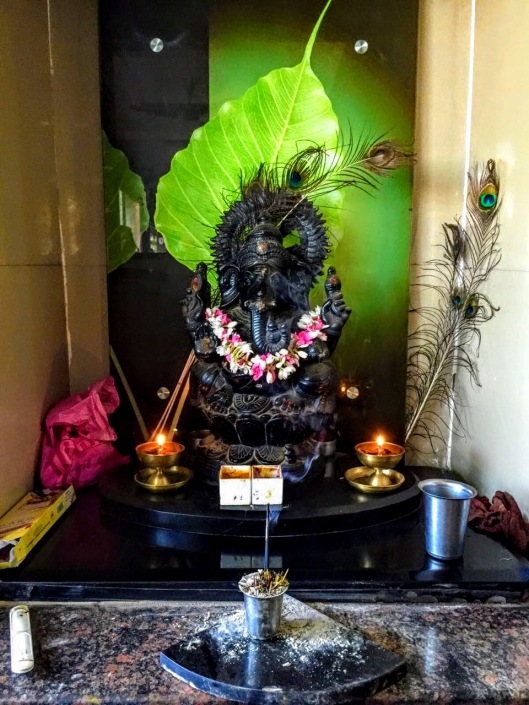
This beautiful Ganesh presided over an early morning breakfast stop. [This and all images below (c)Janine Smith & Jayalakshmi Ayyer 2017]
The art of passing…
My travel besties, Jaya and Janine, showed up in Bangalore a day before I swanned in courtesy of a first-class upgrade. Our driver showed up with the idea that we would be ready to leave at 0:dark-thirtyAM that morning. My luggage did not show up at all.
The plan was that we’d take in a few temples to get back into the swing of India travel, fine-tune the relationship with our driver, and fight the random urge to slip into a jet-lagged coma. (There might be drooling…)
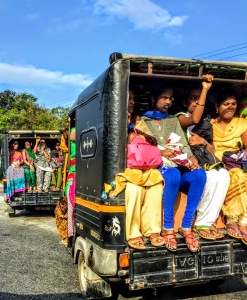 Janine and I were so sleep-deprived, we couldn’t have told what time it was. Or what day. (There was definitely drooling…) But the sounds (non-stop honking), the sights (cows and other animals wandering along the freeway amid entire families on motorbikes or crammed into auto-rickshaws), and the smells (we were back on two-hour feedings) of India soon had us raring to go. (And just in case that becomes literally true, I packed the toilet paper, Jaya packed the bottled water, and Janine packed the Imodium.)
Janine and I were so sleep-deprived, we couldn’t have told what time it was. Or what day. (There was definitely drooling…) But the sounds (non-stop honking), the sights (cows and other animals wandering along the freeway amid entire families on motorbikes or crammed into auto-rickshaws), and the smells (we were back on two-hour feedings) of India soon had us raring to go. (And just in case that becomes literally true, I packed the toilet paper, Jaya packed the bottled water, and Janine packed the Imodium.)
Frankly, I can’t tell you much about that first trip except that we had a good breakfast at Parijata Restaurant under the watchful eye of a cheerful Ganesh in his incense-burning altar with the adjacent large-screen TV showing devotional videos, and a confusing collection of ceramic chef-heads.
When you arrive at an Indian tourist attraction, the decision on whether to hire a guide is only one of many you’ll need to make (along with how long Western feet can go barefoot on hot flagstones when required to shed shoes at temples, if you should be the ONLY one in all of India obeying the NO PHOTOGRAPHY signs, and how much toilet paper you can stuff into your pockets). Our general experience is that most guides spend most of their time reprimanding us. “This way Madam. Madam, look here. Madam, come come. Madam I am telling you…”—by which point Madam has either wandered off to take pictures (Janine), actively interrupted his script by asking random questions (me), or lost all patience and started giving the tour herself since she clearly knows a LOT more history, better stories, and English (Jaya).
Our usual technique has been to read up on the history and significant features before arriving at a site. But if it’s large, if the signage is nonexistent, and if the architecture stunning, we might opt for the guide. We have yet to be glad we did so, and this was no exception. Concluding the expected bargaining session—where the initial fee demanded was reduced to a third despite presentation of a government-issued card documenting his status as a duly-registered guide—our guide directed us to remove our shoes. After barking out orders to follow him around the exterior of the temple and pointing out the obvious features already described at the entry sign, our guide shepherded us into the dim interior. There was a little traffic jam of various tour groups, during which our guide sharply reprimanded several people for touching the carvings. Then he showed us how fine the carving work was by touching them between their carved layers. Repeatedly.
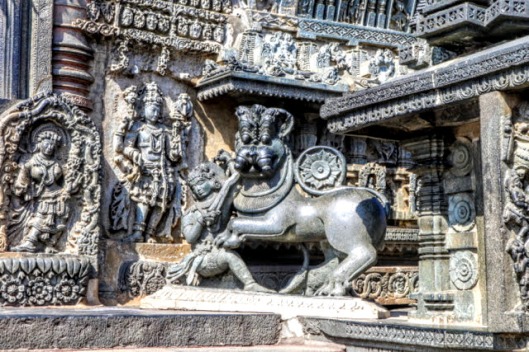
The Chennakeshava Temple, part of the original capital of the Hoysala kings, was commissioned in 1171 by the Hoysala King Vishnuvardhana. Repeated in several places was the tale of boy Prince Sala, who saved the city from a lion.
Finally, the guide briefly turned a searchlight to the intricately carved dome above. We now, he informed us, owed the owner of the searchlight an additional thirty rupees. Perhaps suspecting that a large tip was not coming his way, the remainder of our tour was briskly concluded with a demand from a hitherto invisible attendant for thirty rupees to reward his vigilant protection of our shoes.

The exterior of the temple is covered by thousands of carved sculptures, including 644 elephants—each of them different.
As we put our shoes back on, our guide gabbled off a description of the gravity-defying central pillar and waited hopefully for the additional largesse an unimpressed Jaya would shell out the second hell froze over. The guide wandered off in search of less demanding clients and that’s when I realized that something was very different about this trip. Whenever we’re in India, Janine and I stick out like…well like two pasty white ladies wearing sensible travel clothes amid a sea of Indians in gorgeously colored clothing. Within in moments of arrival, we’d be swamped by vendors—from tiny children to senior citizens proffering strings of flowers, packages of stickers, postcards, flutes playing wobbly Frere Jacques, stone animals—”hand-carved, Madam”, and random strings of gaudy jewelry. The vendors would have to compete with Indian tourists crowding around and shyly asking “selfie with me?”.
But this was the day all that changed, at least for me. I was wearing my bright new kurta (tunic) and salwar (trousers), along with a large pair of sunglasses and a hat, and soon discovered they were like an invisibility cloak. The usual crowds ignored me completely while swarming around Janine, demanding purchases and photos. I hung back and tried to look like a sophisticated Mumbai resident, waving off supplicants with a negligent hand. Meanwhile, Jaya and I watched Janine take photos with everyone and try to be polite:
Vendor: “Madam wants postcard/flute/elephant?”
Janine: “No, thank you. But they are very nice.”
Vendor: “Madam wants flute/postcard/elephant?”
Janine: “No, I…”
Bravest Indian person: “Selfie with me?”
Vendor: “Elephant Madam? Postcard? Flute?”
Janine: “Sure, we can take our picture together. Where are you from?”
Vendor: “Madam wants postcard/flute/elephant?”
Surprised Indian person: “I’m from India. Selfie with me? And the other twenty or thirty people I came with?”
Janine (to Jaya): “Help me.”
Vendor: “Madam wants elephant? Flute? Postcards?”
Janine (to me): “I will get you for this.”
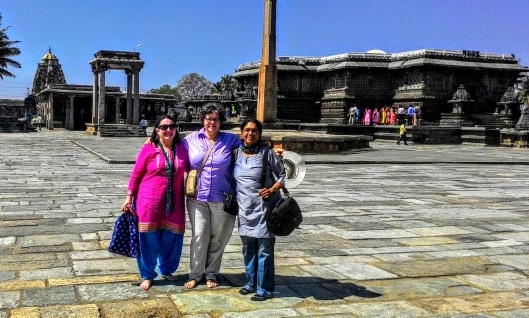
Standing (barefoot) in front of the famous Gravity Pillar, which stands on only 20% of its base, perfectly balanced with no external support.
Who knew passing for Indian while simultaneously throwing one of my oldest friends under the bus would be so much fun? Win-win.
After a traditional tali lunch, we were ready to face the next temple, this time sans guide. The twin monolithic statues of Nandi (the bull companion of the god Shiva) watched with timeless serenity over the stunning remains of the twelfth-century Halebidu temple complex that was still not completed when sacked by fourteenth-century invaders who smashed the faces on the hundreds of carvings.
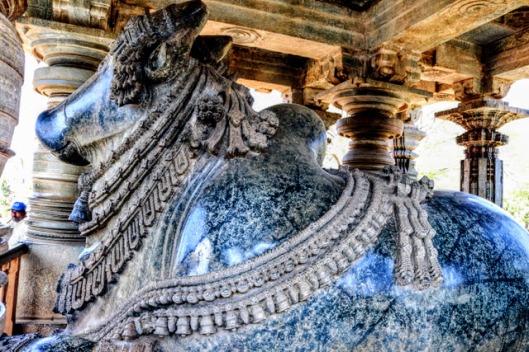
Nandi, the bull companion of the God Shiva, at Halebidu Temple complex. This massive work is one of a pair of monolithic Nandi sculptures which guard the outside of the temple.
On the way back to Bangalore, we stopped at the same restaurant. Ganesh’s incense had burned down and the TV was playing an Indian soap. But in the next room over, an enthusiastic group were playing music and chanting Hari Krishna songs.
We arrived back at Jaya’s kids’ place in Bangalore in a fog of honking vehicles, jetlag, and too much good food to find that her daughter-in-law had made more food. Of course. We were in India.
I asked Janine if she wanted to take a selfie with me.

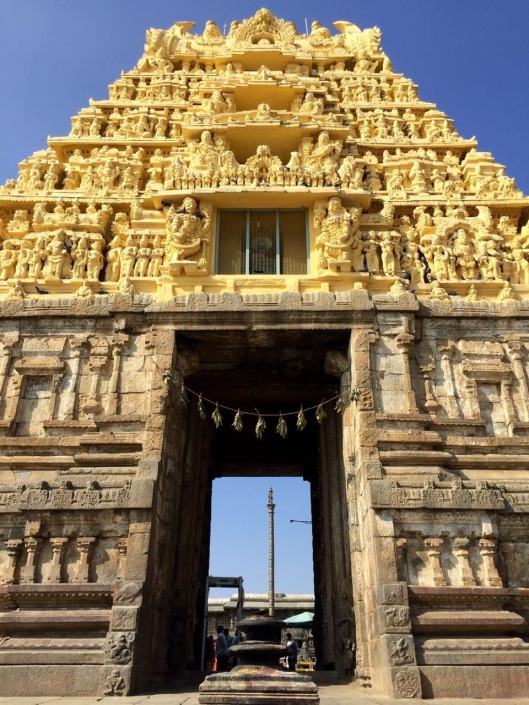

Oh, Barb, I so want to travel with you, somewhere, someday!
LikeLiked by 1 person
Scotland perhaps?
LikeLiked by 1 person
Actually yes! If not this year, than the next one.
LikeLiked by 1 person
Hooray!
LikeLike
I assume your luggage took the option to re-schedule its flight to Bangalore with the other passengers who didn’t run for the plane? Hope it turns up soon.
LikeLiked by 1 person
Yay! It (eventually) caught up with me.
LikeLike
Wonderful to be travelling in India with you again even if only only virtually.
LikeLiked by 1 person
Thanks Mary! It’s pretty fun in the non-virtual world too.
LikeLiked by 1 person
Welcome back! Not sure of your itinerary but is TN in the cards? Just came back from an extraordinary adventure in chettinadu.
LikeLiked by 1 person
We try to stick with one area of India for each trip. This year it’s pretty much Karnataka, with Bangalore as a base.
LikeLike
Top stuff, Barb! I hope this is beginning of Hands/Plates Book 2!!
I wish I was with you as well. What a crack we would have 🙂
LikeLiked by 1 person
I’m not sure that India is ready for us together but it does sound fun.
(India 2.0 is getting wrapped up and these adventures are aimed at 3.0)
LikeLike
How could Madam turn down the offer of a flute? Not to mention an elephant!!! Okay, forget the postcards — rather blasé.
Danny wanted me to ask you, “Who the hell is taking care of the wallpaper hanging pooch?” He tells me he never did get an answer to his query. (Yeah, he uses big words like “query.” He can’t help himself.)
LikeLiked by 1 person
Andrew– Madam is already the proud owner of numerous flutes, pregnant stone elephants, and genuine polyester pashminas.
Danny–Peri is happily visiting Derek, owner of another collie who could be her identical twin, as well as keeper of the keys to a fabulous park at the Veterinary school (where he moonlights from his full time job of doggie companion by pretending to be an animal behaviorist). From the pictures, she looks pretty happy. But I’ll tell her you were worried.
LikeLike
Well, I’d love to be behind you with your guide; Essence of Exasperation will be this year’s Christmas Perfume du Jour – not a big seller but guaranteed to keep the mozzies at bay. Brilliant Barb, you are a joy to travel with – in the last shot were those two carved elephants?
LikeLike
Elephants sir? I’ve got a lovely bunch of coconuts!
LikeLiked by 1 person
I can’t help wondering,Barb, if making visitors take off shoes is really about reverence or more about the thirty rupees it costs to get them back again. I really envy you, though. India must be a fascinating place to visit. (Incidentally, I hope you carefully scrutinized all 644 elephants to make sure they were different from each other.) 😀
LikeLiked by 1 person
We walked all around the temple (ouch ouch) and inspected. Although we had our suspicions about two similar elephants, it was just too hot to go back and verify. Maybe THAT’S the real reason for shoe shedding…
LikeLiked by 1 person
Ah, I see! They don’t want anybody examining the elephants for too long and finding out the terrible secret about numbers 11 and 573.
LikeLiked by 1 person
I love it, you asked Janine if she wanted to take a selfie with you. Did you want to charge her? hehehe. Love your humor! 🙂
LikeLike
Pingback: In lumina
Hope you had a lovely time in India! 🙂
LikeLike
lovely narration…. hope you enjoyed your journey with some new experiences…….
LikeLike
Good pictures
LikeLiked by 1 person